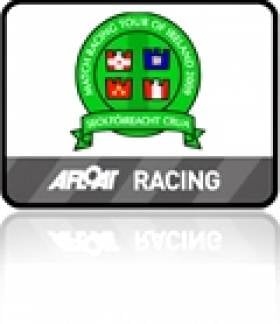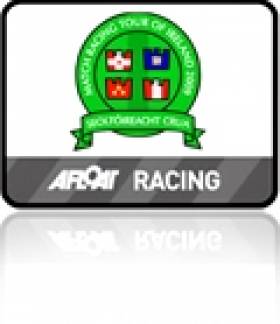Displaying items by tag: Howth Yacht Club
Local Sailing Class Success Takes Good Boats, But Even Better People
As we near the end of the traditional sailing season, inevitably there’ll be heart-searching among boat owners as to the success and value obtained from their summer afloat – can they really justify the expense of continuing to keep a boat? And with so many imponderables in our sport after a summer which was decidedly mixed in its weather - to say the least - the larger sailing community will be scrutinising those classes which seem to be barely hanging in, those classes which are doing quite well, and those few classes which are spectacularly successful. W M Nixon takes a look at the International Dragons in Glandore, the Flying Fifteens in Dun Laoghaire, and the Puppeteer 22s in Howth to try and find that magic Ingredient X which helps - or has helped - these three very different examples to stay ahead of the game.
The wish to own a boat is a vocation, a calling, a quasi-religious emotional endeavour. It’s all very well for high-flown consultants to tell us that if sailing is going to have general appeal and expand, then publicly-accessed freely-available try-a-sail boats will have to be based at every major club. But dedicated sailors know that what comes easy, goes easy. A spell of bad weather, and your jolly public groups who turned up in droves for a bit of free fun afloat will disappear like the will-o’-the-wisps they were in the first place, seeking instead to find somewhere warm and bright and out of the rain and readily providing the latest novel form of entertainment.
Meanwhile, those who are dyed-in-the-wool boat addicts will have barely noticed the idly-interested strangers coming and going. For whatever the weather, they’ve a boat to maintain, gear to repair, a crew to keep together, and some sensible purpose to find in order to give it all deeper meaning. For they know that unless they’ve a boat and her problems and possibilities occupying a significant part of their mind, they’re going to lose the plot completely.
Nevertheless, in the huge spectrum of boat ownership and sailing classes, why is there so much difference in the successful buzz created by some classes at certain localities, as opposed to the dull and declining murmur emanating from classes which are clearly on the way out?
After all, there are very few utterly awful boats afloat. No boat is completely perfect, though some may seem less imperfect than others. But in today’s throwaway world, if some class of boat is not a reasonably good representative of her general type, then she’ll never make the grade in the first place. And even in times past when news and views moved more slowly, the word soon got around if some much-touted type of boat was in truth a woofer.
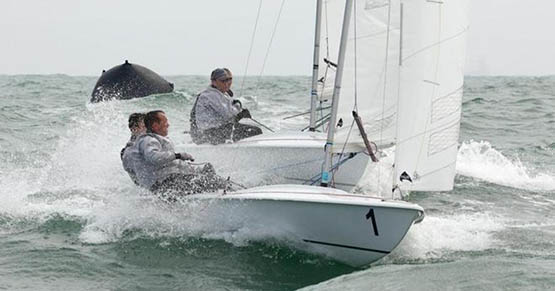
Flying Fifteens provide the best of sport in a very manageable two-man package

The perfect harbour for vintage International Dragons – Glandore, with a goodly selection of classics in port, and Dragons of all ages dotted among them
That said, boat-owning is such an all-consuming passion that once a sailor has finally (or indeed hastily) committed to a particular boat type, then he or she will tend to be absurdly dismissive of any remotely comparable craft. But in the last analysis, the desire to own a boat is irrational. So we shouldn’t be surprised that once the decision is made, irrational attitudes manifest themselves in every direction.
And anyway, as John Maynard Keynes once remarked in a totally different context, in the last analysis we are all dead. So in the meantime, it behoves us to get as much reasonable enjoyment out of life as possible. Thus if owning and sailing a boat is your way of obtaining pleasure without harming anyone else, then good luck to you and me, and let’s look together at boat classes which are doing the business.
In considering the International Dragons in Glandore, the International Flying Fifteens in Dun Laoghaire, and the emphatically not-international Puppeteer 22s in Howth, we are indeed casting the net wide, for really they couldn’t be more different. The 29ft International Dragon originated in the late 1920s from the design board of Johan Anker of Norway, and she has become a by-word for Scandinavian elegance in yacht design, but today she’s totally a racing machine and has strayed far from her original concept as a weekend cruiser for sheltered waters.
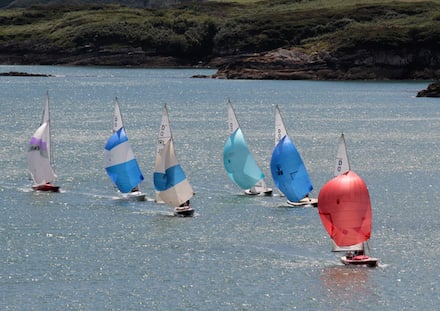
Golden days of classic Dragon racing at Glandore
As for the Flying Fifteen, they originated from designer Uffa Fox having a brainstorm in 1947, in that he took the underwater hull section of the renowned International 14 dinghy in which he was something of a master both as designer and sailor, but above the waterline he drew out the bow to an elegant curved stem, then he lengthened the gentle counter lines to finish in a long sawn-off transom. That done, he added a little hyper-hydrodynamic bulb ballast keel which seemed very trendy, but in truth it’s severely lacking in useful lateral resistance. Nevertheless it gives the boat the reassuring feel of being a small keelboat rather than a big dinghy, and atop it all he put the rig of an International 14 dinghy of that era.
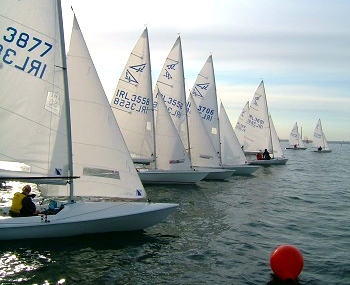
The clean lines of a modern Flying Fifteen fleet. Try to imagine that within each hull there’s an International 14 dinghy, and above it is the original rig
The result was a boat which is really only useful for racing, and it is a design so much of its times that it’s said that many years later the designer himself tried to disown it. But the owners would have nothing to do with this, they liked the compact and very manageable racing-only package which the Flying Fifteen provides, and these days the class has an interesting world spread, and an attractive policy of staging their World Championships at agreeable sunshine destinations where – thanks to their guaranteed ability to turn up with a fleet of viable size – they can arrange block discounts to provide the owners with a very appealing package.
After the sheer internationality of the Dragons and the Flying Fifteens, the Puppeteer 22s are something of a culture shock, as almost every one in existence has ended up based in Howth, where they have such a busy club programme that they only very seldom go south of the Baily, though they do have one annual adventure to Malahide for the Gibney Classic, and once a year they take part in the historic Lambay Race. But otherwise, they’re totally and intensely focused on club racing off Howth.

The Puppeteer 22s seldom stray far from their home port of Howth, for at home they get superbly close racing with a fleet of up to 26 boats in evening racing. This is former ISA President Neil Murphy racing hard at the helm of Yellow Peril, neck and neck with Alan Pearson’s Trick or Treat. Photo: W M Nixon
They were designed by Chris Boyd of Strangford Lough in the mid 1970s to be fractionally-rigged mini-offshore racers, and in all about thirty-three of the Puppeteer 22s were built by C & S Boyd in Killyleagh (Sarah was Chris’s wife). For a while it looked as though they might take off as a semi-offshore One Design class in the north, but somehow they began to trickle down to Howth. They appealed to those sailors who felt that the alternative of a Ruffian 23 with her huge masthead spinnaker was a little too demanding on crews, whereas the Puppeteer’s fractional rig is fairly easily managed. And today the class in Howth is in such good health that even in the poor weather of 2015 they were obtaining regular midweek evening racing best turnouts of up to 26 boats.
Obviously the Puppeteer 22s are now very much a completely localised phenomenom. But while the Flying Fifteens in Dun Laoghaire and the Dragons in Glandore may be representatives of well-established international classes, the fact is in both cases their neighbourhood success is largely due to a distinct local flavour driven by individual enthusiasm. And in Glandore while it’s recognized that the vintage Dragon class was started by Kieran and Don O’Donohue with the classics Pan and Fafner, the man who beats the drum these days for the racing at Glandore as providing “the best and cheapest Dragon racing in the world” is the inimitable Don Street.
Most people will expect that they will be slightly older than the boats they own, and the older you get the greater you’d expect the age gap to be. But Don’s classic Dragon Gypsy is 82 years old. Yet Don himself manages to be that proper little bit senior to her, as he’s 85 and still full of whatever and vinegar, as they’d say in his native New England.
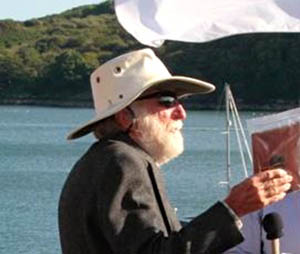
The one and only Don Street in his beloved Glandore. His International Dragon Gypsy is 82 years old, but he still manages to be the senior partner at 85.

Conditions are pleasantly sheltered for the Dragons in Glandore Harbour, but when the fleet goes offshore – as seen here for last year’s championship - they can find all the breeze and lively sea they might want, and more.
The things that Don has done with Gypsy – between intervals of the renowned ocean voyaging with his 1905-built yawl Iolaire which he has now sold – are remarkable, as he sailed Gypsy from Glandore to the classic regatta in Brittany, which is a prodigious offshore passage for an open cockpit racing boat along what the rest of the world would see as significant portions of the most exposed parts of the Fastnet Race course.
Yet although he did such wonderful business with Gypsy on great waters, he has no doubt that the secret of Glandore Dragon racing’s local success is the sheer nearness and convenience of it all. “Down to the pier and out to the boat in five minutes, the starting line is right there, and we don’t race those boring windward-leewards, rather we use club buoys, government navigation marks, islands - and lots of rocks……”
His argument is that with lovely Glandore Harbour being such an fascinating piece of sailing water, part of the interest in keeping up the pace in a local class lies in using those local features, rather than pretending they simply don’t exist by setting courses clear of the land. But of course when the Glandore fleet – which continues as a mix of classic wooden and glassfibre boats – hosts a major event such as last year’s Nationals – which was won by Andrew Craig of Dun Laoghaire in Chimaera – then the courses are set in open water, and they’d some spectacular sailing with it.
In many ways Glandore is a special case, as the population swells in summer with people coming for extended vacations. When that’s the case, their commitment to local Dragon racing can be total, and not least of the occasional local summertime alumni is the great Lawrie Smith. He may have won the Dragon Gold Cup from a fleet of 66 boats last month in Germany under the burgee of another club, but when he’s racing Dragons in Ireland, he’s emphatically under the colours of Glandore Harbour Yacht Club.
Despite these glamorous international links, it’s the folk on the home ground with their dedication to the Dragon Class in Glandore who keep it all going, and it’s Don Street with his dogged determination to prove you can run a Dragon out of pocket money, regardless of the megabucks some might be ready to splash out, which gives the Glandore Dragons that extra something. And in the end it’s all about people, and shared enthusiasm. If you’ve a warm feeling about the Dragon class, and particularly for classic boats in it, then you know that in Glandore you’ll find fellow enthusiasts and every encouragement.
But up in Dun Laoghaire, if you take a look over the granite wall on to the east boat park at the National Yacht Club in summer, and see there the serried ranks of apparently totally identical Flying Fifteens all neatly lined up on their trailers, you could be forgiven for thinking it’s all just ever so slightly clinical, and certainly distinctly impersonal.
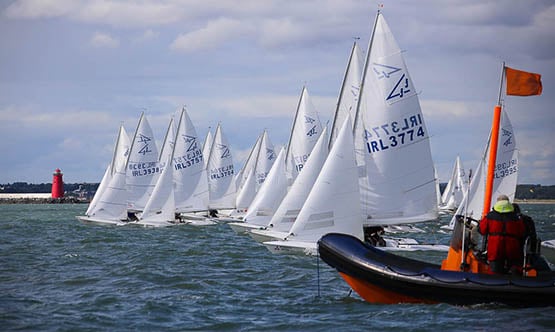
Just about as one design as they could be – the fine fleet at last weekend’s Flying Fifteen Irish Championship in Dublin Bay showed the vigour of the class, which has 47 ranked helmsmen in this country.
Yet you couldn’t be more utterly wrong. Today’s Flying Fifteens may have been technically refined to the ultimate degree to give maximum sport for the minimum of hassle. But their current runaway success – they’re far and away the biggest keelboat One Design class in Dublin Bay – is down to a friendly and very active local class association, and its readiness to reach out the hand of friendship and encouragement to anyone who might be thinking of joining the class’s ranks.
Recently the pace has been set by class captain Ronan Beirne, who recognises that simply announcing and advertising an event is not enough. You have to chivvy people and encourage them into their sailing – particularly after a summer remembered as having had bad weather – and then far from sitting back and smugly counting numbers, you have to keep at it, seeing that crewing gaps are filled, and that those on the fringes are brought to the centre.
The Flying Fifteens – which are essentially a National YC class – offer exceptional value and a very manageable package. The boats are dry-sailed in their road trailers, and instead of queuing for a crane, they have a rapid rota of slip-launching, with the expectation of renewing the wheel bearings each year. Salt water and road trailers are not good partners, but in order to ensure the most efficient launching and retrieval of the boats after each day’s racing, replacing wheel bearings has become something of an art.
The class in Dun Laoghaire secured good sponsorship from Mitsubishi Motors at the beginning of the year, and the sponsors in turn have been rewarded by a thriving class in which inter-personal friendships have developed to such a healthy state that you might find people crewing for someone who would be a complete and untouchable rival at other times in many other classes, but in the Dun Laoghaire Flying Fifteens he’s a fellow enthusiast who happens to be short of a crew on that day.
One of the enthusiastic newcomers to the class this year is Brian O’Neill, who originally hailed from Malahide and was best known for campaigning the family’s Impala 28 Wild Mustard with great success for several years, but now he’s very much a family man living in Dun Laoghaire with three growing kids, and sailing had gone on to the back burner.
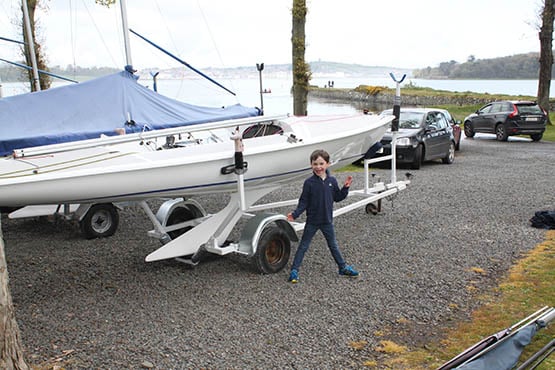
Charlie O’Neill (aged 7) at Strangford SC with dad Brian’s newly acquired Flying Fifteen. Under the rapid moving launching system at the National YC, the dry-sailed Flying Fifteens use their road trailers to get the boats afloat in record time. The need for regular replacement of the wheel bearings is allowed for in each boat’s budget. Photo: Brian O’Neill
But as the National YC is just down the road from where he lives, he was drawn into its welcoming ambience, and soon became aware of the attractive and friendly package offered within the club by the Flying Fifteens. He bought one in good order from an owner at Strangford Sailing Club in the Spring, and was soon in the midst of it. Yet it takes up only a very manageable amount of his time, it simply couldn’t be more convenient, and the people are just great too.
Who knows, but having won the class’s last evening race of the 2015 season, he might even be prepared to travel to maybe one event at another venue in Ireland. But the primary attraction continues to be the class’s strong local ethos and ready racing at the National, the friendliness of fellow Flying Fifteen sailors, and the sheer manageability of the whole thing – this is not a boat where the ownership gets on top of you.
If you want to get the flavour of Dun Laoghaire Flying Fifteen racing, you get a heightened sense of it from the report in Afloat.ie of how David Gorman and Chris Doorly won last weekend’s Irish championship in classic style, and if this isn’t good value in sailing and personal boat ownership, then I don’t know what is.
Across Dublin Bay in those misty waters of Fingal beyond the Baily, your correspondent found himself reporting aboard Alan “Algy” Pearson’s Puppeteer 22 Trick or Treat last Saturday for the opening race of the MSL Park Motors Autumn League. I did so with some trepidation, for Alan has a super young crew recruited from Sutton Dinghy Club in the form of GP14 ace Alan Blay, Ryan Sinnott and Claud Mollard, but our cheerful skipper said that as the day was brisk, they needed the fifth on board for ballast.
In fact, I’d only once raced a Puppeteer before, in the lightest of winds when somehow we managed a win. But as this race progressed with the skipper and his young tacticians making a perfect call for the long beat in a good long course which made full use of the splendid sailing waters north of Howth, by the last leg after many place changes it looked as though another win might be on the cards.

Action stations. Puppeteer 22s closing in for their start. Photo: W M Nixon
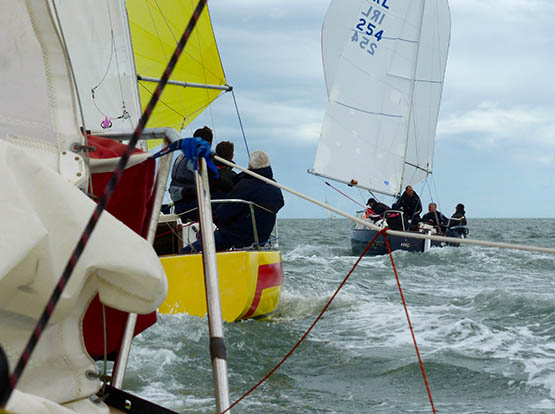
At mid-race, Gold Dust led narrowly from Yellow Peril, but by the start of the last beat, Trick or Treat was leading from Gold Dust with Yellow Peril third. Photo: W M Nixon
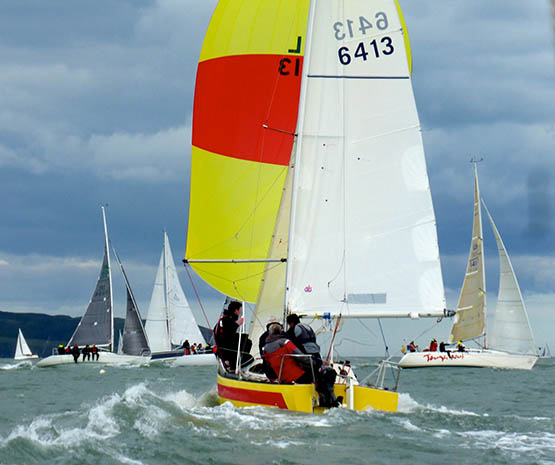
In the MSL Park Motors Autumn League, the mix of classes can sometimes make for interesting situations. Having out-gybed Gold Dust, Yellow Peril is ploughing towards some biggies on another course altogether, and meanwhile there’s the inevitable lobster pot lurking on the way with just one tiny white marker buoy. Photo: W M Nixon
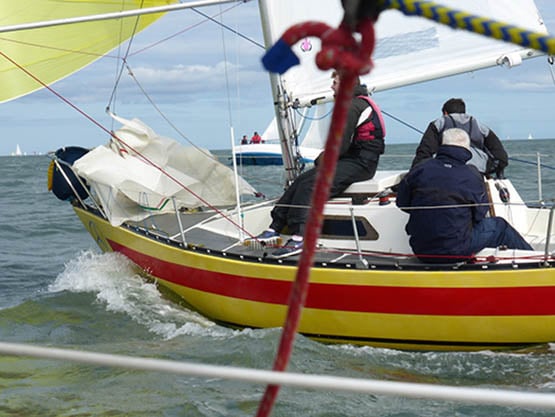
Algy Pearson’s Trick or Treat giving Yellow Peril a hard time to snatch the lead, which she then increased with a cleverly-read long beat. Photo: W M Nixon
But the pace in the Puppeteers is ferocious, and though we’d got a bit of a gap between Trick and former IDRA 14 empress Scorie Walls in Gold Dust, one sneeze from us and Gold Dust would pounce, and alas - we sneezed.
As long as we were carrying the no 2 headsail (what I’d call the working jib) we were level pegging with the formidable Walls-Browne team. But Gold Dust has a lovely new suit of sails (nice ones, Prof), and when the easing wind meant we’d to change up to the genoa, it emerged as a sail of a certain age, and having it set sapped our confidence.
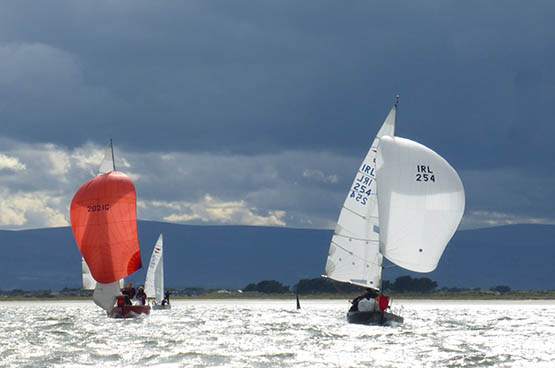
It looked for a while as though Gold Dust (254) had been put fairly comfortably astern……..Photo: W M Nixon
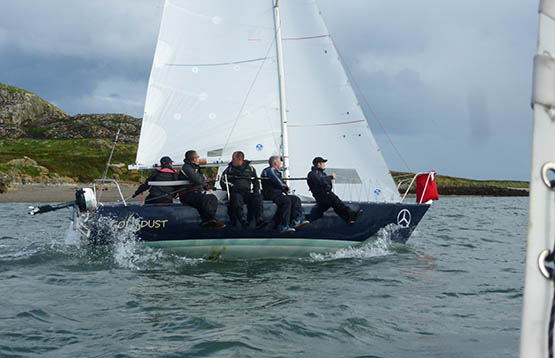
……but an easing of the wind saw Gold Dust finding new speed, and with perfect tactics she was right there with just a hundred metres to go to the finish. Photo: W M Nixon
Until then, the boat had been sailed magnificently, tactics right, trim right, and throwing gybes with such style that the downwind pace never missed a beat. But trying to get that genoa right was a mild distraction, so when Scorie the Queen of the Nile came round the final mark to chase us up the last beat to weather Ireland’s Eye, we’d failed to throw a precautionary tack to keep a loose cover, and suddenly as she rounded she found a local favourable but brief shift of 15 to 20 degrees, and then it was all to play for.
Dissecting it all afterwards (you’ll gather it was a post mortem), we could see two places where we might have still saved the day, but we didn’t grab them, or maybe in truth they were beyond our reach. Whatever, Gold Dust was in the groove and we weren’t. Madam beat us by three seconds. But the banter afterwards and the evidence that Puppeteer people – owners and crews alike – move happily among boats to keep turnout numbers up, was ample proof that here was another truly community based class which perfectly meets a strong local need.

That winning feeling…..Gold Dust’s crew relax after taking first by three seconds. Photo: W M Nixon

The Howth experience. Howth YC Commodore Brian Turvey heads back to port after racing the MSL Autumn League with the Howth 17 Isobel which he co-owns with his brother Conor. Photo: W M Nixon
It had been a great day’s sport, and the Puppeteers being of an age and regularly turning out to race together, they run both a scratch and a handicap system, which is a great improver of local classes – after all, where would golf be without handicaps?
It shows how well Gold Dust has been going this year that her rating is such that we beat her on handicap by one minute and 19 seconds, but we in turn, having been second on scratch, were fourth on handicap, where the winner was the O’Reilly/McDyer team with Geppeto.
Forty years after they first appeared, the Puppeteer 22s are giving better sport than ever, but in a very local context rather than on the bigger stage that might have been anticipated. Yet for their current owners, they do the business and then some. For most folk, this is sailing as it should be. And as to this longterm success of classes which continue to thrive whether they come from a local, national or international background, certainly the quality of the boats is important to some extent. But mostly, it’s the people involved, and their realization that you’ll only get as much out of sailing as you put into it.
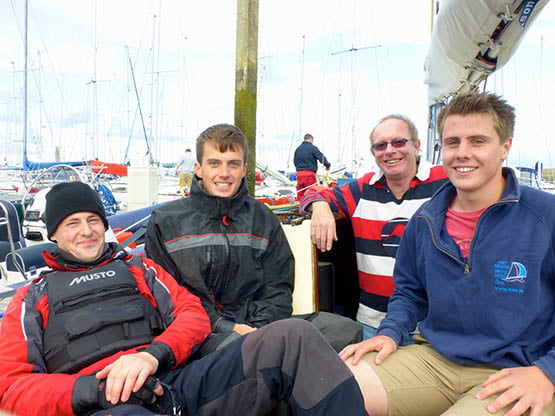
A super crew. Aboard Trick or Treat after racing are (left to right) Alan Blay, Ryan Sinnott, Alan Pearson and Claud Mollard. Photo: W M Nixon

Local man, local boat. Algy Pearson with his Puppeteer 22 Trick or Treat. The Pearsons have been sailng from Howth for three generations. Photo: W M Nixon
Howth Yacht Club's Gilbert Louis Competes At Model Yacht IOM Mortelecque Trophy Regatta
Gilbert Louis (IRL141) from Howth Yacht Club competed at the IOM Mortelecque Trophy regatta in Valenciennes the weekend of the 12th & 13th September and reports here for Afloat.ie
Gilbert joined his brother in France and together made the trip up to Valenciennes arriving after just over 2 hour car journey to a typical French breakfast welcome… Et oui! A coffee with a croissant… hmmmm nice!
Very quickly it was time to rig up the boats, confirm the registration and boat cert before we were out for the first race. It was very well organised.
21 boat which is about the max IOM can realistically sail together. Anything above this and the fleet is broken down into 2 fleets with 4 boats moving each way (top 4 boats from B fleet progressing to A and last 4 of the A fleet going down to B fleet for the next race). This provided for some well disputed starts. And Starts were key to the end result as the top weather mark was not that far.
The IOM class only allows 3 rigs to cover winds up to 30-35 knots. Here there was no question on the choice of rig. Despite a forecast for 11-21 knots we had 6-10 knots max all day, so top rig it was for everyone.
Gilbert races a Goth XP IOM boat designed by Frank Russell Design from Australia, built in wood by our national Irish master-craftsman Neill Suitor from our Northern Ireland fleet. Gilbert was the only wooden boat racing there.
Gilbert found the pace early one with 3 5th place for the first 3 races establishing him in 3rd place after 3 race. But then as the wind got even lighter Gilbert found difficult to find the same pace. Whilst he manage to get in the top 3 a number of time he didn’t manage to finish better then 5th.
After day 1 and 11 races completed Gilbert found himself in 8th place out of 21 boats.
Day 2 was pretty much the same wind but this time coming 180 degree from the Saturday. But as light if not lighter at times. Once again Gilbert didn’t break the top 5 despite once again sail in the top 3 even leading some of the races at times. This was frustrating! His boat was outpointing pretty much everyone else but Gilbert was looking to find speed not pointing and despite making tuning changes between each race only found some marginal speed improvements.
Nonetheless this was a really good experience to gain as Gilbert knows what he needs to work on. A new main with the max draft in different location, a bigger rudder is on the works to try next. And this is part of the tuning when you sail a new design boat. This is part of the fun too!
At the end of day 2 Gilbert had progressed and built a nice gap in 6th place overall. The event was won by Guillaume Florent (Bronze Olympic medallist in Finn class).
100 Entries For First Race of Howth Yacht Club's Autumn League
The first race of this year’s Howth Yacht Club MSL Park Motors Mercedes Benz sponsored Autumn League turned out to be a firm ‘shake-down’ for many of the competitors and their boats this Saturday. The overnight gales had subsided in time for the afternoon starts and almost 100 entries enjoyed lively racing across their nine participating classes in 18-21 knots of wind, flat seas and warm sunshine.
The fresh south-westerly wind enabled the ‘Inshore’ and ‘Offshore’ race management teams set up courses that spanned the full width of the racecourses from the Cush and West marks which are close to the Baldoyle and Portmarnock shores, across to the ‘East’ mark which is positioned north-east of Ireland’s Eye.
The ‘Cruiser’ classes were given a 2-hour race and it was no surprise to see many of the more experienced racing teams finish at the top of each fleet. Pat Kelly’s J109 ‘Storm’ revels in Howth’s annual autumnal keelboat series and emerged victorious in Class 1 while Stephen Quinn’s ‘Lambay Rules’ proved that the team’s recent run of form (including a top spot the Welsh IRC Nationals) will be one to watch in the seriously competitive Class 2 fleet. Other boats racing in this class include Dave Cullen’s ‘Checkmate XV’, the Colwell/Cobbe Corby 25 ‘Fusion’, Anthony Gore Grimes’s ‘Dux’, Michael and Ritchie Evans’s ‘The Big Picture’ and other Half Tonners – Jonny Swan’s ‘Harmony’ and the Kelly/ Boardman owned ‘K1’. The 20 boats entered in this class are all capable of podium positions and many have been champions at other regattas already this year.
Class 3 will see Howth’s K25 team challenge for top spot and affords them the opportunity of rotating their newly expanding team for some competitive racing against the very experienced racers in that Class. The Non-Spinnaker Classes saw a margin of less than a minute separate ‘White Lotus’ and ‘Splashdance’ (Class 4) and a formidable 1,2,3 in Robert Michael’s ‘Mystique’, Harry Byrne’s ‘Alphida’ and Windsor Lauden and Steffi Ennis’s ‘Demelza’ challenge the first race of a very interesting line-up in Class 5.
The ‘Inshore’ classes enjoyed 90-100 minutes racing in the fresh conditions. Alistair Kissane (1st) and Simon Rattigan battled it out on the J80 racecourse, which should see very close racing throughout the series. It was business as usual in the Puppeteer class, where the Walls/Browne partnership in ‘Gold Dust’ started the series with the same determination that won them last year’s overall prize – crossing the finish line 3 seconds ahead of Alan Pearson’s ‘Trick or Treat’. Keeping their powder dry for the remainder of the series, the Squib class boats travelled across the bay to compete in their Eastern Championships this weekend. In the Howth 17 Class race, the average wind speed of just less that 20 knots proved to present a reward for the three boats that dared to fly ‘topsails’, with the respective podium places won by Peter Courtney’s ‘Oona’, the Turvey’s ‘Isobel’ and the ‘Deilginis’ conglomerate.
The series continues next week….
Royal Cork Optimist Sailor Takes Allianz Leinster Victory off Howth
Day two of the Optimist Leinster championship at Howth Yacht Club dawned with a lot less wind than the previous one, posing difficulties for sailors and race officers alike.
Launching was slightly delayed as the optimistic sailors waited for the wind to fill in.
The feather weights in the fleet cheered silently whereas the heavy weather sailors hoped that windguru had got it wrong and that perchance 20 knots was on the way.
Race 4 of the championship was completed in 7 knots of breeze and in the senior fleet Cathal O'Regan RCYC took a bullet followed by Jack Fahy Rsgyc. In the juniors Royal Cork took line honours with Michael Crosbie taking first followed by Harry Twomey. After this the longed for discard kicked and places reshuffled.
Race five of the championship was started for the junior fleet in 5 knots of breeze but had to be abandoned after a significant wind shift which would have resulted in an unfair race.
Once again the junior fleet started but after the wind died away the PRO made the wise decision to once again abandon as too much was at stake to risk having a floating race.
Ribs were sent out in all directions in search of the elusive wind which appeared to be playing hide and seek. Finally wind filled in and having moved the course in the direction of Portmarnock one race was completed for both senior and junior fleets. The 3pm deadline for starting a race was fast approaching and having all had a long day on the water and sailed fairly PRO Richard Kissane made the wise decision to send the fleet home.
Local sailor and overnight leader Dylan O'Grady had to concede to Cathal O'Regan for Leinster Championship honors as the cork sailor won out on count back. In the Junior Fleet Aoife Byrne was the outright winner followed by the National Yacht Clubs Conor Gorman who had improved tremendously on his position from yesterday.
The Regatta fleet once again had a great days sailing and PRO Des Flood managed to get one race in which was won by HYC's Sarah Evan's. The overall winner of the regatta fleets 4 races was John Twomey.
The top 5 winners in the Senior and Junior Fleets are listed below.
Senior Fleet
1 Cathal O'Regan Royal Cork Yacht Club
2 Dylan O'Grady Howth Yacht Club
3 Kate Darcy Royal Cork Yacht Club
4 Tom Higgins Royal St. George Yacht Club
5. Charlie Cullen National Yacht Club
Junior Fleet
1 Aoife Byrne Royal Cork Yacht Club
2 Conor Gorman. National Yacht Club
3 Rory O'Sullivan. Royal Cork Yacht Club
4 Harry Twomey Royal Cork Yacht Club
5 Leah Rickard National Yacht Club
Congratulations to the event management and hospitality teams in HYC chaired by ISA board member Robert Dix for hosting a fantastic event.
This concluded the IODAI event roundup for the season. Prizes were awarded first to the. Regatta Fleet sailors and then later the main prize giving concluded at 5 pm.
Congratulations to all the sailors who have learnt so much over the season see you all next year!
Howth Yacht Club's Dylan O'Grady Leads at Allianz Optimists
Howth Yacht Club hosts the final day of the Leinster Optimist Championships this morning with in excess of 150 entries. Saturday dawned bright and if not sunny, exceedingly pleasant. The wind was from the north approx 12 knots and the there was definitely an autumnal nip in the air.
Richard Kissane as PRO started the proceeding at 11 am with a sailors briefing and the sailors launched shortly afterwards. It was a beat out to the course beside Irelands eye but luckily the tide had turned and helped the sailors on their way. After the sailors had launched refreshments and home made goodies were served to parents with donations going to Crumlin Children's Hospital.
3 races were completed on the main fleet course with the wind dropping over the course of the day to approx 6 knots and times and veering slightly easterly. HYC's own Dylan O'Grady had a stormer of a day with a 1st, 2nd and third but he can't rest on his laurels just yet as Kate Darcy from RCYC is hot on his heels a mere one point behind followed slightly further back on 12pts by Tom Higgans.
Over in the Junior Fleet (aged 12 and under) Aoife Byrne from RCYC is leading the charge winning the first two races and taking a 4 th in the 3 rd she is followed by the home clubs Eve McMahon and her own team mate Rory O'Sullivan.
Regatta fleet sailors sailed in the sheltered waters behind Aqua restaurant under the watchful eye of lead coachs Mark Condy and Emma Davis. They had a fantastic days sailing as they practised the skills learnt over the season. 3 short races were also completed for these younger sailors with Thomas O'Neill, Juilette Garett and John Toomey each taking a race win.
HYC's hospitality didn't disappoint and the sailors were served delicious spaghetti bolognese with garlic bread followed by ice cream in the main dining room of the club.
Racing continues today and with lighter winds forecast it's still all to play for...
Howth Yacht Club Drone Captures Optimist Dinghy Championships
#matchracing – Howth's Yacht Club's Diana Kissane faces strong opposition in Denmark at the Women's Match Racing World Championship and yesterday strong gusts and a long day conspired to really test the sole Irish entry who sustained six losses, the same as Finnish and Dutch entries
Local hope Lotte Meldgaard and French Anne-Claire Le Berre are the only undefeated skippers after the opening day of the 2015 ISAF Women's Match Racing World Championship, the first event on the 2015 Women's International Match Racing Series (WIM Series), in Middelfart, Denmark. Both scored 8 - 0 on a long and very action-packed Wednesday:
"Even with one reef in the main and a smaller jib replacing the genoa, the Match 28's we're racing here are quite overpowered. We lost control a couple of times, but excellent crew work got us back on track again" Meldgaard comments.
The opening day offered truly challenging conditions for the competitors as well as for the race management. Gusts approaching 30 knots swept down the course, leaving broaching boats, freely flying kites and wet and exhausted sailors behind.
The racing in Middelfart continues with the round-robin Thursday and Friday, while the weekend will see the exciting knock-out rounds to crown the World Champions.
Standings after one day of round-robin in the 2015 ISAF Women's Match Racing World Championship in Middelfart, Denmark, the first event on the 2015 WIM Series (skipper, country, wins - losses):
1. Lotte Meldgaard, DEN, 8 - 0
1. Anne-Claire Le Berre, FRA, 8 - 0
3. Anna Östling, SWE, 7 - 1
4. Camilla Ulrikeholm, DEN, 5 - 1
4. Caroline Sylvan, SWE, 5 - 1
6. Stephanie Roble, USA, 4 - 2
6. Klaartje Zuiderbaan, NED, 4 - 2
8. Pauline Courtois, FRA, 5 - 3
8. Katie Spithill, AUS, 5 - 3
10. Milly Bennett, AUS, 3 - 5
11. Louise Christensen, DEN, 2 - 6
12. Johanna Larsson, SWE, 0 - 6
12. Nina Ramm-Schmidt, FIN, 0 - 6
12. Rikst Dijkstra, NED, 0 - 6
12. Diana Kissane, IRL, 0 - 6
16. Sanna Hager, SWE, 0 - 8
#matchrace – Howth Yacht Club's Diane Kissane and her crew are competing at this week's ISAF Women's Match Racing World Championship in Denmark, as Afloat previously reported back in May. Warm and sunny conditions with a strong southerly breeze today welcomed the 81 sailors participating in the 2015 ISAF Women's Match Racing World Championship, the first event out of four on the 2015 Women's International Match Racing Series (WIM Series), to Middelfart, Denmark. The rain waited politely until the last practise session in Match Racing Denmark's fleet of Match 28 boats was over:
"It takes a while to learn a new boat, but we've also had some practise on our home waters and feel quite confident going into this event," says World # 1 and defending World Champion Anna Ostling.
During Tuesday's practise session in Middelfart the Swedish crew of Team Anna had a few great fights against last year's World Championship bronze medallist and WIM Series # 4, American Stephanie Roble of Epic Racing:
"It's a shifty and tricky venue and we were happy to be controlling the Swedes a lot of the time. I like the boats a lot, they spin quickly and it's good to be five on board," Roble comments.
By Sunday we'll not only know which of the top ranked sailors has captured the World Championship title, but also who gained points on this first event out of four on the 2015 WIM Series. The first two years of the WIM Series saw 39 professional teams from 19 countries competing for gold and glory.
2015 ISAF Women's Match Racing World Championship teams (skipper, country, ISAF World Ranking):
Anna Ostling, SWE, 1
Camilla Ulrikkeholm, DEN, 2
Stephanie Roble, USA, 3
Anne-Claire Le Berre, FRA, 4
Lotte Meldgaard, DEN, 5
Caroline Sylvan, SWE, 6
Klaartje Zuiderbaan, NED, 7
Pauline Courtois, FRA, 8
Milly Bennett, AUS, 9
Johanna Larsson, SWE, 13
Nina Ramm-Schmidt, FIN, 14
Katie Spithill, AUS, 16
Sanna Hager, SWE, 17
Rikst Dijkstra, NED, 18
Diana Kissane, IRL, 60
Louise Christensen, DEN, 6
#sb20worlds – Shane Murphy, Daragh Sheridan and John Phelan of Howth Yacht Club lead Irish hopes at the SB20 Worlds in Italy. The Dublin trio are 20th in a fleet of 98 after six races sailed and might well have been higher only for a black flag scored in the last race this afternoon. Full results HERE.
Three races completed on Day 2 with the 98-boat fleet now divided into 'gold' and 'silver' fleets, determining who can challenge for the title. But there's nothing to split the leaders, with two teams tied on points after six races.
Torbole provided more classic conditions at Lake Garda for the second day of the 2015 SB20 World Championships, with the famous south to south-westerly afternoon 'Ora' breeze allowing six more races to be held, three each for the two qualifying fleets. The qualifying series is now over and one discard comes into play. Eight more races are scheduled – with just one discard allowed from the final races: there is no room for error over the next three days.
The large international entry is now split into Gold and Silver fleets, with the Gold fleet leaders vying for the title of 2015 World Champion. Competition couldn't be tighter, with the lead two boats each tied on 12 points apiece. Roger Hudson's South African 'Race Ahead – Spirit of Cape Town' had a super-consistent day, scoring a fourth and two seconds, while the French youth team 'Give me 5' from the FFV opened their day with a win, and went on to score another second and fourth.
Robin Follin of 'Give me 5' commented after racing: "So far in the regatta we've wanted to sail 'safe' so as to make it into the Gold fleet. Now we know our boat is fast, so tomorrow we should take more risks!"
Early leaders Ian Ainslie and Italian crew have dropped to third on 17 points after counting a sixth and fifth from today's races. There is little to split the fourth placed Russian team of Alexey Murashkin, who took two seconds today to end on 23 points, and the highly-fancied Ukrainian entry skippered by Rodion Luka, who is lying in fifth on 24 points. Luka scored two race wins today, but also finished in 19th place in the day's opener, which forces his 'Sky Line' team to count an earlier 12th place on their scoreline.
The first British boat is Joe Llewellyn in sixth place with 'Forelle Estates', who picked up his first race win of the championships today. He is tied on points with seventh-placed Russian entry Vladimir Prosikhin on 'Nika'. The first of a strong Australian entry is Glenn Bourke and Robert Jeffreys, currently in ninth place.
SB20 World Council Class President Ed Russo, who is racing on 'Black Magic' in eighth place, said: "It is extremely tough out there. The competition is incredibly tight and it's great to see the youth teams coming to the fore. We are looking forward to the final series – where it's going to get even tougher for sure!"
For some teams the no-hold-barred nature of the championship led to disappointment ashore, with Pieter Heyn and Rob Gullan's 'F5 Synthesis Team Gul' (GBR) picking up two OCS scores on today's competitive startlines. The Black Flag also caught a couple of boats out in the final race of the day. There was more disappointment still for Richard McAdam and team on 'Here Comes Bod' (GBR) scoring three DNFs today, after failing to sail with the correct fleet.
Those teams now in the Silver fleet aren't out of contention for a prize haul, as class builder and supplier Sportsboat World will be sponsoring the Silver fleet with separate bounty up for grabs, and from tomorrow the leaders in that division will be flying the famous bright pink spinnaker (Tour de France yellow jersey-style).
SportsboatWorld are also sponsoring a 'Nations Cup' prize for the best aggregate score for the top three teams from each nation overall. The main contenders expected to compete for this include France, Italy, Russia, Ukraine, UK, Australia and Ireland. Inevitably, with UK and Australia as the two leading teams currently some 'Ashes style' rivalry is developing...
Squib Title Settled in Howth After Three–Way Tie
#squib – A three-way tie at the top of the 2015 Squib Nationals leaderboard was settled in favour of David Jones and Mark Hogan from South Caernarvonshire Yacht Club writes Emmet Dalton. Saturday's final race was led from start to finish by the duo. That race saw the second overall going to their clubmates Nigel Harris and John Stephenson. The champagne-splashed podium was completed by Malcolm Hutchings and Andy Ramsey from Royal Corinthian Yacht Club.
On the final day, Principal Race Officer, David Lovegrove, set the fleet off under the U-Flag penalty system after some misbehaving during the first attempt. The 20kt southeasterly breeze in glorious Howth sunshine, with five 1,700m windward legs, made sure that the crews got their bang for buck. Without exception, "Squib Arse" was suffered by hard-hiking sailors! The visiting sailors would later express their gratitude to David for his skill and engagement with a fleet that enjoyed his communicative banter on the VHF all during the week.
The event was made all the more epic by the championship dinner. Even the traditional Howth Seventeen Footer Class would have been impressed by the array of precious metals and rare timbers presented. Top Irish boat was "Aficionado" (RNIYC), hard driven by John Driscoll and David Cagney to 9th place. The leading HYC Squib was the super-slippery "Kerfuffle" in the hands of Emmet Dalton and Neal Merry which ended the week in 22nd place.
Woe betide anyone who thinks that grey (or no) hair indicates an easy crew to pass. Such was the quality of the fleet that one previous champion noted that he would have been happy to end up in the top ten at the end of the week!
Howth looked fabulous in a week of sun and the competitors enjoyed a warm welcome from the members and fabulous food and service. So good was the championship dinner that the Squib Association Chairman announced that it was the best meal at any Squib Championships in 40 years! That opinion was roundly applauded by the 130 guests.
Thanks was also expressed to the Race Office team, Orla Sweeney, Dara and Lara Jameson, Emma Inglis and Alice Kissane and to the ever-watchful Fergus O'Kelly and his group of friendly tape-wielding equipment inspectors for ensuring that each boat complied with the rules.
Launching, berthing and retrieval of the boats was coordinated like a North Korean political rally by Pat McCaughey. Slick!
Finally, the top speed of the week was shared by "Alchemy" from Royal Yorkshire Yacht Club and Howth's "Kerfuffle" both hitting 10.2kts during Monday's screaming reaches.
Additional reporting Vincent Delany
SQUIB NATIONALS 2015- day 6- Final Day.
The level and depth of talent in the 49 boat National Squib fleet was seen in today's race off Ireland's Eye at Howth. The wind was between 15 and 20 knots from the south-east. The outcome of the Squib Championship 2015 was yet to be decided. The three leading contenders being Malcolm Hutchings and Andy Ramsay from R.C.Y.C. in 'Lady Penelope', on 12 points, Nigel Harris and John Stephenson. S.C.Y.C., in 'Banshee', on 14 points, and David Jones and Mark Hogan, from S.C.Y.C. in 'Ric O'Shea', on 20 points. Which of these talented sailors had the ability to pull the championship out of the bag?
Unusually, the scoring system used allowed for two discards in eight race series. Would the winner be an older boat such as 'Banshee', no.65, or 'Ric O'Shea', no.136, or would it be the newer boat, 'Lady Penelope', no. 819? There was another significant variable in the mix, would the winner use Batt Sails or Hyde Sails? 'Ric O'Shea' is the only one of the three to use a complete wardrobe of Batt Sails the others only use Hyde Sails.
The course selected by race officer Dick Lovegrove was Course Number Two, a windward-leeward race of with five beats of 1.7km. each. The sea conditions were a little 'lumpy', and the tide was due to change mid-race.
On the start line the tide was flowing against the Squibs, which enabled the fleet to start on their first attempt, without recourse to the 'U' flag, which had been used for most of the races earlier in the week. The race officer did not use the dreaded 'black flag' at any race this week.
On the first beat against the tide it was 'Ric O'Shea' which appeared to get the bit between their teeth. The wind was steady in strength and direction, so it was a boatspeed race. At the first windward mark 'Ric-O-Shea' led from Gerard Dyson and Tony Saltonstall in 'Alchemy'. The locally Howth based 'Too Dee' sailed by Dave and Simon Sheahan rounded the mark within the top six boats. 'Banshee' rounded in about eighth place and 'Lady Penelope' about five places behind. These two had a lot of work to do, it was going to be a long nine mile race. On each round 'Ric O'Shea' sailed to her pre-determined tactical plan, and increased her lead until she was more than 100m. ahead of the bunch of Squibs following. 'Crossfire' sailed by Dave Best and Pete Richards worked their way into second place.
At the last leeward gate marks it appeared that 'Lady Penelope' had done enough to take her place on the podium and lift the championship trophy. But there was still one more beat to be completed, and the tide had turned. 'Lady Penelope' and 'Banshee' rounded different leeward gate marks, and by the end of the beat at the finish line, 'Banshee' had overhauled her opponent. As they passed the finish line the order was:
1st. 'Ric O'Shea', 136, David Jones and Mark Hogan, S.C.Y.C.
2nd. 'Crossfire' 797, Dave Best and Pete Richards, S.C.Y.C.
3rd. 'Alchemy', 800, Gerard Dyson and Tony Saltonstall, R.Y.Y.C.
4th.'Helmut Shoing II', Nigel and Jack Grogan, R.C.Y.C.
5th. 'White Magic', David Wines and Keith Davies, W.H.S.C.
6th. 'Moonstone', Malcolm Blackburn and David Shiel, S.C.Y.C.
7th. 'Pani-Munta', Mike Probert and Richard Delves, R.C.Y.C.
8th. 'Banshee', Nigel Harris and John Stephenson. S.C.Y.C.
9th. 'Lady Penelope', Malcolm Hutchings and Andy Ramsay. R.C.Y.C.,
So, who had won the championship?
Remarkably after eight races and two discards, 'Ric O'Shea', 'Banshee', and 'Lady Penelope' were all on equal points. Each had 21 points after discards.
'Ric O'Shea' discarded a 15th. and 21st. place. 'Lady Penelope' discarded 25th. and 26th. places. 'Banshee' discarded an 8th. and 29th. These figures are not relevant under the current scoring system, where a draw is resolved by the highest place boat in the last race which, as noted above, was won by 'Ric O'Shea.
RESULTS OF THE NATIONAL SQUIB CHAMPIONSHIP 2015.
1st. 1st. 'Ric O'Shea', 136, David Jones and Mark Hogan, S.C.Y.C.
2nd. 'Banshee', 65, Nigel Harris and John Stephenson. S.C.Y.C.
3rd. 'Lady Penelope', 819, Malcolm Hutchings and Andy Ramsay. R.C.Y.C.,
The top Irish Squib is 'Aficionado', 78, John Driscoll and David Cagney in 9th place.
Of the top ten places overall, 4 were from South Caernarvonshire Y.C., 4 were from Royal Corinthian Y.C., one from Royal North of Ireland Y.C., and one from Royal Yorkshire Yacht Club, which indicates that strong fleets at the local clubs are significant to developing the boatspeed necessary to win championship races under all conditions.
The top lady helmsman is Megan Pascoe with crew Hannah Stodel in 'Squibble' from Weymouth who finished in 31st. place. Their performance in this fleet is commendable. The also won the trophy for the top 'ParaSquibbers'. They were thrilled by the friendly and welcoming atmosphere which exists in the Squib fleet. They are newcomers in this fleet, and are more accustomed to the 2.4m. class, and Sonar parolympic circuits.


























